Pioneer AVH-P5200DVD, AVH-P5200BT User Manual

Operation Manual
DVD AV RECEIVER
AVH-P5200DVD
AVH-P5200BT
English
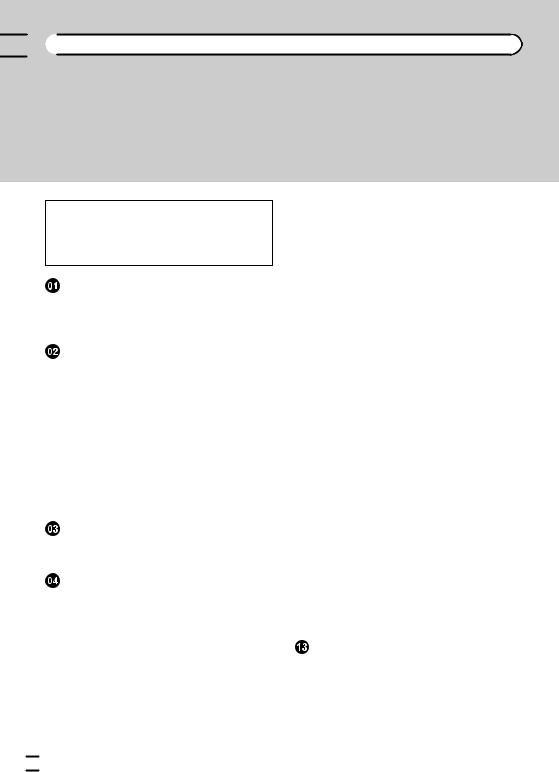

 Contents
Contents
Thank you for purchasing this PIONEER product.
To ensure proper use, please read through this manual before using this product. It is especially important that you read and observe WARNINGs and CAUTIONs in this manual. Please keep the manual in a safe and accessible place for future reference.
 Be sure to read this
Be sure to read this
!DVD video disc region numbers 8
!Handling guideline 82
Precautions |
|
|
|
|
|
|
|
IMPORTANT SAFEGUARDS |
5 |
|
|
||||
To ensure safe driving |
|
5 |
|
|
|
||
To avoid battery exhaustion |
6 |
|
|
||||
Before You Start |
|
|
|
|
|
||
Information to User |
7 |
|
|
|
|
||
For Canadian model |
7 |
|
|
|
|
||
About this unit |
7 |
|
|
|
|
|
|
Operating environment |
8 |
|
|
|
|||
After-sales service for Pioneer products |
8 |
||||||
Visit our website |
8 |
|
|
|
|
|
|
Protecting your unit from theft |
8 |
|
|||||
Resetting the microprocessor |
9 |
|
|||||
Feature demo mode |
9 |
|
|
|
|
||
Adjusting the response positions of the |
|
||||||
touch panels (Touch Panel Calibration) |
9 |
||||||
What’s what |
|
|
|
|
|
|
|
Head unit 10 |
|
|
|
|
|
|
|
Optional remote control |
10 |
|
|
|
|||
Basic Operations |
|
|
|
|
|
||
Basic Operations 11 |
|
|
|
|
|||
Operating the scroll bar and the scrubber |
|
||||||
bar |
12 |
|
|
|
|
|
|
Activating the touch panel keys |
13 |
|
|||||
Common operations for menu settings/ |
|
||||||
lists |
13 |
|
|
|
|
|
|
Opening and closing the LCD panel 13 |
|
||||||
Ejecting a disc |
14 |
|
|
|
|
|
|
Ejecting an SD |
15 |
|
|
|
|
|
|
Setting the clock |
15 |
|
|
|
|
|
|
 Tuner
Tuner
Introduction of tuner operations 16
 Playing moving images
Playing moving images
Introduction of video playback operations 17
 Playing audio
Playing audio
Introduction of sound playback operations 20
 Playing still images
Playing still images
Introduction of still image playback operations 23
Introduction of still image playback as a slideshow operations 24
 Bluetooth Telephone
Bluetooth Telephone
Introduction of Bluetooth telephone operations 25
 XM/SIRIUS tuner
XM/SIRIUS tuner
Introduction of XM/SIRIUS tuner operations 27
 HD Radioä tuner
HD Radioä tuner
Introduction of HD Radioä tuner operations 29
 Using Bluetooth wireless technology
Using Bluetooth wireless technology
Introduction of Bluetooth telephone
operations 30 |
|
Bluetooth audio operations |
31 |
Detailed instructions |
|
Storing and recalling stations |
33 |
Storing the strongest stations |
33 |
Tuning in to strong signals 33 |
|
Tuning in to strong HD Radio signals 33 Using iTunes tagging 34
Switching the media file type 34 Operating the DVD menu 35
 2
2 En
En

 Contents
Contents
Operating this unit’s iPod function from your iPod 35
Random play (shuffle) 35
Playing all songs in random order (shuffle
all) 36 |
|
|
|
Repeating playback |
36 |
|
|
Playing videos from your iPod |
36 |
|
|
Browsing for a video/music on the iPod |
36 |
||
Resume playback (Bookmark) |
37 |
|
|
Frame-by-frame playback 37 |
|
|
|
Slow motion playback |
37 |
|
|
Searching for the part you want to play |
38 |
||
Changing audio language during playback (Multi-audio) 38
Changing the subtitle language during playback (Multi-subtitle) 38
Changing the viewing angle during playback
(Multi-angle) |
39 |
|
|
|
Return to the specified scene |
39 |
|
||
Selecting audio output 39 |
|
|
|
|
PBC playback |
39 |
|
|
|
Selecting tracks from the track title list |
39 |
|||
Selecting files from the file name list |
40 |
|||
Using advanced sound retriever |
40 |
|
||
Changing audiobook speed |
40 |
|
|
|
Displaying lists related to the currently |
|
|||
playing song (Link Search) |
40 |
|
||
Playing DivXÒ VOD content |
40 |
|
|
|
Capture an image in JPEG files |
41 |
|
||
Changing the wide screen mode |
41 |
|
||
Switching the XM/SIRIUS channel selection mode 42
Selecting an XM/SIRIUS channel directly 43
Using the MyMix function |
43 |
|
Using the Game Alert function |
45 |
|
Displaying the Radio ID |
46 |
|
Switching the SIRIUS display |
46 |
|
Using the Instant Replay function 46 Switching the seek mode 47
Switching the reception mode |
47 |
|
|
|||||||
Calling a number in the phone book |
47 |
|
||||||||
Selecting a number by alphabet search |
|
|||||||||
mode |
|
47 |
|
|
|
|
|
|
|
|
Using the missed, received and dialed call |
||||||||||
lists |
48 |
|
|
|
|
|
|
|
|
|
Using the missed, received and dialed call |
||||||||||
lists |
48 |
|
|
|
|
|
|
|
|
|
Setting automatic answering |
49 |
|
|
|
||||||
Adjusting the other party’s listening |
|
|
||||||||
volume |
49 |
|
|
|
|
|
|
|
|
|
Switching the ring tone |
49 |
|
|
|
|
|||||
Using the preset dial lists |
49 |
|
|
|
|
|||||
Making a call by entering phone number |
49 |
|||||||||
Setting the private mode |
50 |
|
|
|
|
|||||
Pairing from this unit |
50 |
|
|
|
|
|
||||
Using a Bluetooth device to pair |
51 |
|
|
|||||||
Connecting to a Bluetooth device |
|
|
|
|||||||
automatically |
51 |
|
|
|
|
|
|
|||
Switching visible unit |
51 |
|
|
|
|
|
||||
Displaying BD (Bluetooth Device) |
|
|
|
|||||||
address |
52 |
|
|
|
|
|
|
|
|
|
Entering PIN code for Bluetooth wireless |
|
|||||||||
connection |
52 |
|
|
|
|
|
|
|
||
Using a cellular phone to initiate a |
|
|
|
|||||||
connection |
52 |
|
|
|
|
|
|
|
||
Registering a connected cellular phone |
52 |
|||||||||
Voice recognition |
53 |
|
|
|
|
|
|
|||
Connecting a Bluetooth audio player |
53 |
|
||||||||
Connecting to a Bluetooth device |
|
|
|
|||||||
automatically |
53 |
|
|
|
|
|
|
|||
Displaying BD (Bluetooth Device) |
|
|
|
|||||||
address |
53 |
|
|
|
|
|
|
|
|
|
Menu operations |
|
|
|
|
|
|
|
|||
Introduction of menu operations |
54 |
|
|
|||||||
Audio Adjustments |
55 |
|
|
|
|
|
||||
Setting up the DVD player |
58 |
|
|
|
|
|||||
System settings |
62 |
|
|
|
|
|
|
|||
Entertainment settings |
67 |
|
|
|
|
|||||
En  3
3


 Contents
Contents
Customizing menus 68
 Other Functions
Other Functions
Changing the picture adjustment 69 Setting rear monitor output 69 Adjusting the response positions of the
touch panels (Touch Panel
Calibration) |
70 |
|
Using an AUX source |
70 |
|
Using an external unit |
71 |
|
Additional Information |
||
Troubleshooting |
72 |
|
Error messages |
74 |
|
Understanding auto EQ error messages 77 Understanding messages 78
Indicator list 80 Handling guideline 82
Compressed audio compatibility (disc, USB, SD) 84
iPod compatibility 85 Sequence of audio files 86
Using the display correctly |
86 |
|
Copyright and trademark |
87 |
|
Language code chart for DVD |
89 |
|
Specifications 91 |
|
|
 4
4 En
En

|
Section |
Precautions |
01 |
IMPORTANT SAFEGUARDS
Please read all of these instructions regarding your display and retain them for future reference.
1Read this manual fully and carefully before operating your display.
2Keep this manual handy as a reference for operating procedures and safety information.
3Pay close attention to all warnings in this manual and follow the instructions carefully.
4Do not allow other persons to use this system until they have read and understood the operating instructions.
5Do not install the display where it may (i) obstruct the driver’s vision, (ii) impair the performance of any of the vehicle’s operating systems or safety features, including air bags, hazard lamp buttons or (iii) impair the driver’s ability to safely operate the vehicle.
6Do not operate this display if doing so in any way will divert your attention from the safe operation of your vehicle. Always observe safe driving rules and follow all existing traffic regulations. If you experience difficulty in operating the system or reading the display, park your vehicle in a safe location and make necessary adjustments.
7Please remember to wear your seat belt at all times while operating your vehicle. If you are ever in an accident, your injuries can be considerably more severe if your seat belt is not properly buckled.
8Never use headphones while driving.
9To promote safety, certain functions are disabled unless the parking brake is on, and the vehicle is not in motion.
10Never set the volume of your display so high that you cannot hear outside traffic and emergency vehicles.
 WARNING
WARNING
!Do not attempt to install or service your display by yourself. Installation or servicing of the display by persons without training and experience in electronic equipment and automotive accessories may be dangerous and could expose you
to the risk of electric shock or other hazards.
To ensure safe driving
 WARNING
WARNING
!LIGHT GREEN LEAD AT POWER CONNECTOR IS DESIGNED TO DETECT PARKED STATUS AND MUST BE CONNECTED TO THE POWER SUPPLY SIDE OF THE PARKING BRAKE SWITCH. IMPROPER CONNECTION OR USE OF THIS LEAD MAY VIOLATE APPLICABLE LAW AND MAY RESULT IN SERIOUS INJURY OR DAMAGE.
!To avoid the risk of damage and injury and the potential violation of applicable laws, this unit is not for use with a video screen that is visible to the driver.
!To avoid the risk of accident and the potential violation of applicable laws, no viewing of front seat video should ever occur while the vehicle is being driven.
!In some countries or states the viewing of images on a display inside a vehicle even by persons other than the driver may be illegal. Where such regulations apply, they must be obeyed and this unit’s DVD features should not be used.
When you attempt to watch a video image while driving, the warning Viewing of front seat video source while driving is strictly prohibited. will appear on the front display. To watch a video image on the front display, park your vehicle in a safe place and apply the parking brake.
Precautions
En  5
5

Section |
|
01 |
Precautions |
Parking brake interlock
Certain functions (Video viewing and certain touch panel keys) offered by this unit could be dangerous and/or unlawful if used while driving. To prevent such functions from being used while the vehicle is in motion, there is an interlock system that senses when the parking brake is set. If you attempt to use the functions described above while driving, they will become disabled until you stop the vehicle in a safe place, and (1) apply the parking brake, (2) release the parking brake, and then (3) apply the parking brake again. Please keep the brake pedal pushed down before releasing the parking brake.
When using a display connected to REAR MONITOR OUTPUT
This unit’s REAR MONITOR OUTPUT is for connection of a display to enable passengers in the rear seats to watch the DVD or Video CD.
 WARNING
WARNING
NEVER install the rear display in a location where the driver can watch a DVD while driving.
!Please note that the edges of the rear view camera images may differ slightly according to whether full screen images are displayed when backing up, and whether the images are
used for checking the rear when the vehicle is moving forward.
To avoid battery exhaustion
Keep the vehicle engine running when using this unit to avoid draining the battery power.
!When no power is supplied to this unit, such as when the vehicle battery is being replaced, the microcomputer of this unit returns to its initial condition. We recommend that you transcribe the audio adjustment data.
 WARNING
WARNING
Do not use with vehicles that do not feature an ACC position.
When using the rear view camera
With an optional rear view camera, this unit can be used as an aid to keep an eye on trailers, or when backing into a tight parking spot.
 WARNING
WARNING
!SCREEN IMAGE MAY APPEAR REVERSED.
!USE INPUT ONLY FOR REVERSE OR MIRROR IMAGE REAR VIEW CAMERA. OTHER USE MAY RESULT IN INJURY OR DAMAGE.
 CAUTION
CAUTION
!The rear view camera function is to be used as an aid to keep an eye on trailers, or while backing up. Do not use for entertainment purposes.
 6
6 En
En

|
Section |
Before You Start |
02 |
FCC ID: AJDK027
MODEL NO.: AVH-P5200BT IC: 775E-K027
This equipment complies with FCC/IC radiation exposure limits set forth for uncontrolled equipment and meets the FCC/IC radio frequency (RF) Exposure Guidelines in Supplement C to OET65. This equipment has very low levels of RF energy that it deemed to comply without maximum permissive exposure evaluation (MPE). But it is desirable that it should be installed and operated with at least 20 cm and more between the radiator and person’s body (excluding extremities: hands, wrists, feet and ankles).
This transmitter must not be co-located or operated in conjunction with any other antenna or transmitter.
This device complies with part 15 of the FCC Rules. Operation is subject to the following two conditions:
(1) This device may not cause harmful interference, and (2) this device must accept any interference received, including interference that may cause undesired operation.
Information to User
Alteration or modifications carried out without appropriate authorization may invalidate the user’s right to operate the equipment.
For Canadian model
This Class B digital apparatus complies with Canadian ICES-003.
About this unit
The tuner frequencies on this unit are allocated for use in North America. Use in other areas may result in poor reception.
 WARNING
WARNING
Handling the cord on this product or cords associated with accessories sold with the product may expose you to chemicals listed on proposition 65 known to the State of California and other governmental entities to cause cancer and birth defect or other reproductive harm. Wash hands after handling..
CAUTION:
USE OF CONTROL OR ADJUSTMENT OR PERFORMANCE OF PROCEDURES OTHER THAN THOSE SPECIFIED HEREIN MAY RESULT IN HAZARDOUS RADIATION EXPOSURE.
CAUTION:
THE USE OF OPTICAL INSTRUMENTS WITH THIS PRODUCT WILL INCREASE EYE HAZARD.
 CAUTION
CAUTION
!Do not allow this unit to come into contact with liquids. Electrical shock could result. Also, damage to this unit, smoke, and overheating could result from contact with liquids.
!Keep this manual handy for future reference.
!Always keep the volume low enough to hear outside sounds.
!Avoid exposure to moisture.
!If the battery is disconnected or discharged, any preset memory will be erased.
 Important (Serial number)
Important (Serial number)
The serial number is located on the bottom of this unit. For your own security and convenience, be sure to record this number on the enclosed warranty card.
Start You Before
En  7
7
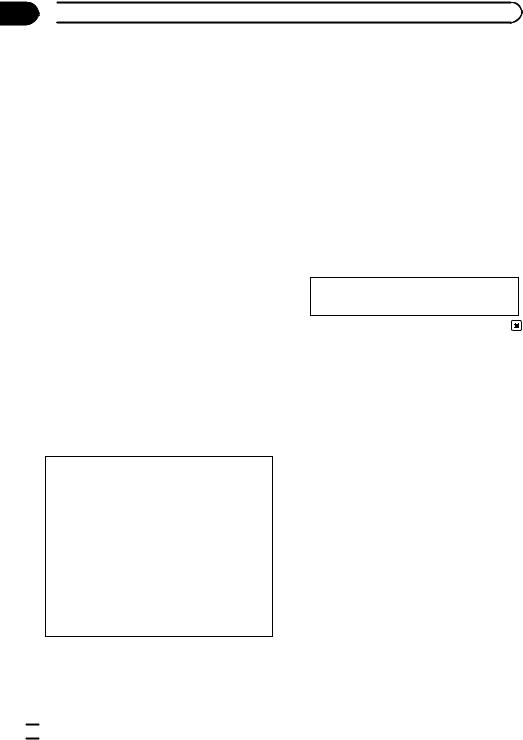
Section
02  Before You Start
Before You Start
DVD video disc region numbers
Only DVD video discs with compatible region numbers can be played on this player. You can find the region number of the player on the bottom of this unit and in this manual (refer to
Specifications on page 91).
Operating environment
This unit should be used within the temperature ranges shown below.
Operating temperature range: -10 °C to +60 °C (14 °F to 140 °F)
EN300328 ETC test temperature: -20 °C and +55 °C (-4 °F and 131 °F)
Visit our website
Visit us at the following site: http://www.pioneerelectronics.com
1Register your product. We will keep the details of your purchase on file to help you refer to this information in the event of an insurance claim such as loss or theft.
2Receive updates on the latest products and technologies.
3Download owner’s manuals, order product catalogues, research new products, and much more.
4Your feedback is important in our continual effort to design and build the most advanced, consumer-focused product in the industry.
Serial number
After-sales service for Pioneer products
Please contact the dealer or distributor from where you purchased this unit for after-sales service (including warranty conditions) or any other information. In case the necessary information is not available, please contact the companies listed below:
Please do not ship your unit to the companies at the addresses listed below for repair without advance contact.
U.S.A.
Pioneer Electronics (USA) Inc. CUSTOMER SUPPORT DIVISION P.O. Box 1760
Long Beach, CA 90801-1760 800-421-1404
CANADA
Pioneer Electronics of Canada, Inc. CUSTOMER SATISFACTION DEPARTMENT 300 Allstate Parkway
Markham, Ontario L3R 0P2 1-877-283-5901 905-479-4411
For warranty information please see the Limited Warranty sheet included with this unit.
Protecting your unit from theft
The front panel can be detached to deter theft.
!If the front panel is not detached from the head unit within four seconds of turning off the ignition, a warning tone will sound.
!You can turn off the warning tone. Refer to
Switching the warning tone on page 64.
 Important
Important
!Handle gently when removing or attaching the front panel.
!Avoid subjecting the front panel to excessive shock.
!Keep the front panel out of direct sunlight and high temperatures.
!If removed, replace the front panel on the unit before starting up your vehicle.
 8
8 En
En
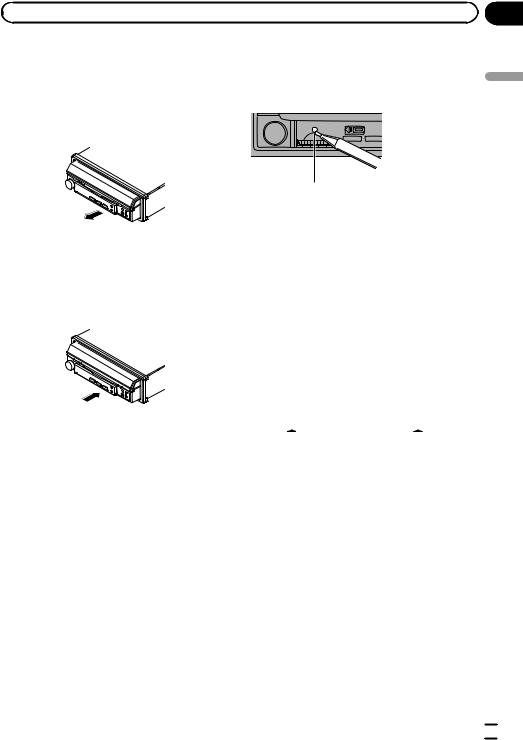
|
Section |
Before You Start |
02 |
Removing the front panel
% Pinch the top and bottom of its right side and pull the front panel out.
Take care not pinch it too tightly or to drop it, and also avoid contact with water or other fluids to prevent permanent damage.
Re-attaching the front panel
1 Slide the front panel to the left.
Front panel and the head unit are connected on the left side. Make sure that the front panel has been properly connected to the head unit.
2 Press RESET with a pen tip or other pointed instrument.
For this function, verify the following section before operation. Refer to this page.
RESET button
 Note
Note
Switch your engine ON or set the ignition switch to ACC ON before pressing RESET in the following situations:
!After completing connections
!When erasing all stored settings
!When resetting the unit to its initial (factory) settings
Start You Before
2 Press the right side of the front panel until it is firmly seated.
# If you can’t attach the front panel to the head unit successfully, try again. However, forcing the front panel into place may result in damage.
Resetting the microprocessor
By pressing RESET, you can reset the microprocessor to its initial settings without changing the bookmark information.
The microprocessor must be reset in the following situations:
!Before using this unit for the first time after installation
!If the unit fails to operate properly
!When strange or incorrect messages appear on the display
1 Turn the ignition switch OFF.
Feature demo mode
The feature demo automatically starts when you select Off for the source and continues while the ignition switch is set to ACC or ON. To cancel the feature demo, press and hold MUTE/ . Press and hold MUTE/
. Press and hold MUTE/ again to restart. Operating the feature demo while the car engine is turned off it may drain the battery power.
again to restart. Operating the feature demo while the car engine is turned off it may drain the battery power.
 Important
Important
Failure to connect the red lead (ACC) of this unit to a terminal coupled with ignition switch on/off operations may lead to battery drain. 
Adjusting the response positions of the touch panels (Touch Panel Calibration)
If you feel that the touch panel keys on the screen deviate from the actual positions that respond to your touch, adjust the response positions of the touch panel. Refer to Adjusting the response positions of the touch panels (Touch Panel Calibration) on page 70.
En  9
9
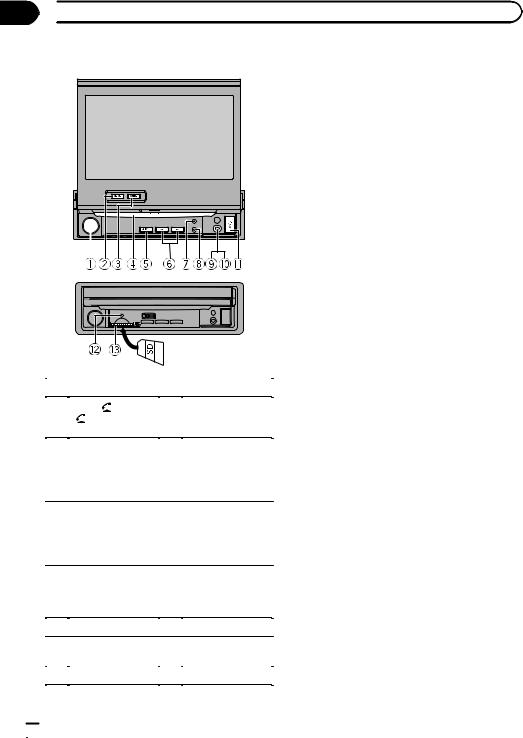
Section
03  What’s what
What’s what
Head unit
 CAUTION
CAUTION
!Use an optional Pioneer USB cable (CD-U50E) to connect the USB audio player/USB memory as any device connected directly to the unit will protrude out from the unit and may be dangerous.
!Do not use unauthorized products.
!For details on how to operate a navigation unit from this unit, refer to its operation manual.
 Note
Note
When the navigation unit is connected, press MODE to switch to the navigation display. Press MODE and hold to turn the display off.
Press MODE again to turn the display on.
Optional remote control
The remote control CD-R55 is sold separately.
For details concerning operations, see the remote control manual.
|
Part |
|
Part |
|
MUTE/ |
|
|
1 |
( : AVH-P5200BT |
8 |
OPEN/CLOSE |
|
only) |
|
|
|
|
|
|
|
MENU |
|
AUX input jack (3.5 |
|
Displaying the |
|
mm stereo/video |
2 |
menu. |
9 |
jack) |
|
Returning to the |
|
Use to connect an |
|
normal display. |
|
auxiliary device. |
|
|
|
|
|
|
|
Auto EQ micro- |
|
MODE |
|
phone input jack |
3 |
Turning the infor- |
a Use to connect an |
|
|
mation display off. |
|
auto EQ micro- |
|
|
|
phone. |
|
|
|
|
|
|
|
USB port |
4 |
Disc loading slot |
b |
When connecting, |
open the USB con- |
|||
|
|
|
nector lid. |
|
|
|
|
5 |
SRC/OFF |
c |
RESET |
|
|
|
|
6 |
c/d (TRACK) |
d |
SD memory card |
slot |
|||
|
|
|
|
7 |
h (eject) |
|
|
|
|
|
|
 10
10 En
En
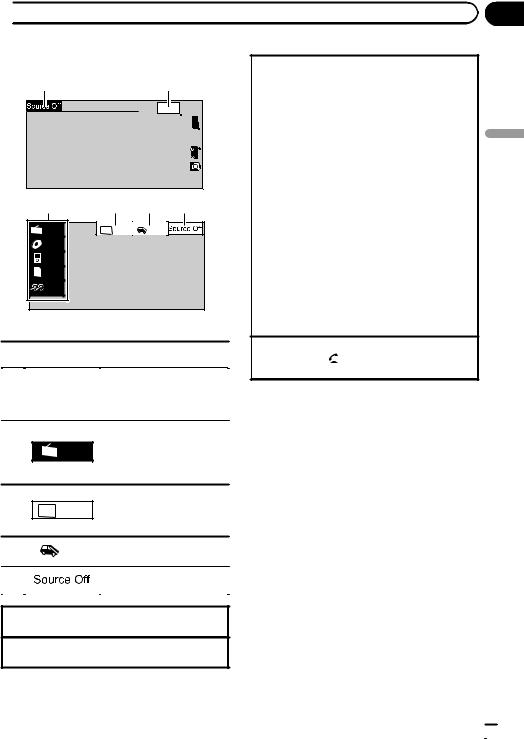
 Basic Operations
Basic Operations
Basic Operations
1 2
Wed 28 may
12:45 PM
|
3 |
4 |
5 |
6 |
|
Radio |
Rear Front |
Rear |
|
|
View |
|
||
|
Disc |
|
|
|
|
iPod |
|
|
|
SD |
SD |
|
|
|
|
|
|
|
|
|
AUX |
|
|
|
1 Touch panel keys
1 |
|
|
|
Displaying the source menu. |
|
|
|
|
|
|
|
|
|
Switching to clock adjust- |
2 |
|
Wed 28 may |
|
ment display. |
|
12:45 PM |
|
Refer to Setting the clock on |
|
|
|
|
|
|
|
|
|
|
page 15. |
|
|
|
|
|
Source icon
Selecting a favorite source. 3 Radio When the source icon is not
displayed, it can be displayed by touching the screen.
Switching the output source
4 Rear Front for the rear monitor.
Refer to Setting rear monitor output on page 69.
5 |
|
Rear |
Switching the rear view |
|
View |
image on or off. |
|
|
|
||
|
|
|
|
|
|
|
|
6 |
|
|
Turning the unit off. |
|
|
||
|
|
|
|
|
|
|
|
Selecting a source using the buttons
1 Press SRC/OFF to cycle through the sources listed below:
Selecting a source using the touch panel keys
1Touch the source icon and then touch the desired source name.
!XM – XM tuner
!Sirius – SIRIUS tuner
!HD Radio – Digital Radio tuner
!Radio – Radio
!AV – AV input
!Disc – Built-in DVD player
!USB/iPod – USB/iPod
!SD – SD memory card
!EXT1 – External unit 1
!EXT2 – External unit 2
!AUX – AUX
!TEL – Bluetooth telephone/audio (Function of AVH-P5200DVD)
!When the source icon is not displayed, it can be displayed by touching the screen.
!While operating the menu, you cannot select a source by touching the source icon.
Adjusting the volume
1Rotate MUTE/ to increase or decrease the volume.
 Notes
Notes
!In this manual, iPod and iPhone will be referred to as “iPod”.
!The USB/iPod icon will change as follows:
—USB is displayed when a USB storage device is connected.
—iPod is displayed when an iPod is connected.
—USB/iPod is displayed when no device is connected.
!When appropriately set up, the image from the rear view camera can be displayed automatically. For details, refer to Setting the rear view camera (back up camera) on page 65.
Section
04 |
Operations Basic
Turning the unit on using the buttons 1 Press SRC/OFF to turn the unit on.
Turning the unit off using the buttons
1 Press SRC/OFF and hold until the unit turns off.
En  11
11
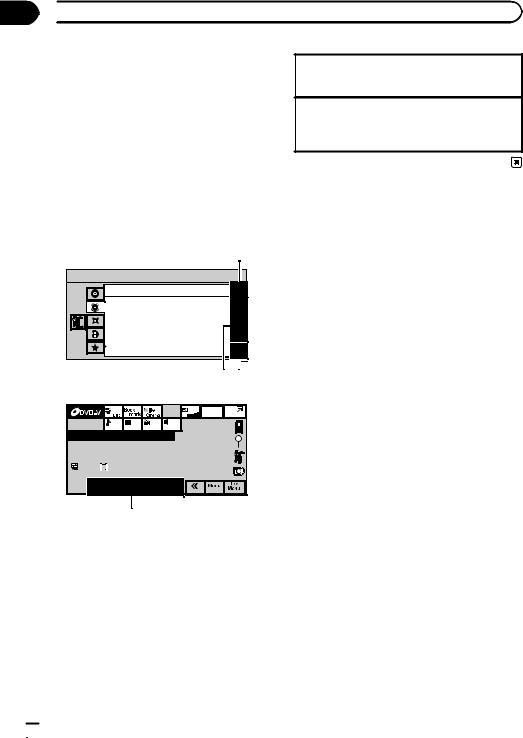
Section
04  Basic Operations
Basic Operations
!An external unit refers to a Pioneer product, such as those which will be available in the future. Although incompatible as a source, the basic functions of up to two external units can be controlled with this unit. When two external units are connected, the external units are
automatically allocated to external unit 1 or external unit 2.
Viewing the hidden items
1Touch the scroll icon or drag the scrubber bar to view any hidden items.
Specifying the playback point
1Drag the scrubber bar on the screen.
(Not available when the scrubber bar is grayed out.)
Operating the scroll bar and the scrubber bar
1
 Audio
Audio
|
|
|
|
Fader/Balance |
F/R 0 L/R 0 |
||||||||
|
|
|
|
Graphic EQ |
|
|
|
|
|
|
|
|
|
|
|
|
|
Super Bass |
|
|
|||||||
|
|
|
|
|
|
|
|
|
|
|
|
||
|
|
|
|
Auto EQ |
|
|
On |
|
|
|
|
|
|
|
|
|
|
|
|
|
|
|
|
|
|
||
|
|
|
|
Sonic Center Control |
|
L/R:0 |
|
|
|||||
|
|
|
|
Loudness |
|
|
|
|
|
|
|
|
|
|
|
|
|
Subwoofer |
|
|
|
|
|
||||
|
|
|
|
|
|
Off |
|
|
|
||||
|
|
|
|
|
|
||||||||
|
|
|
|
|
|
|
|||||||
|
|
|
|
|
21 |
||||||||
01 |
01 |
01 |
L+R |
Abcdeabcdeabcdeabcdeab |
|
||
Wed 28 may
12:45 PM
8 |
|
|
12 |
|
|
|
|
|||
|
|
|
|
|
|
|
|
|
|
|
|
|
|
|
|
01:45 |
|
|
-02:45 |
|
|
|
|
|
|
|
|
|
|
|
|
|
2
1Scroll icon
Appears when selectable items are hidden.
2Scrubber bar
Appears when the playback point can be specified or set by dragging.
 12
12 En
En
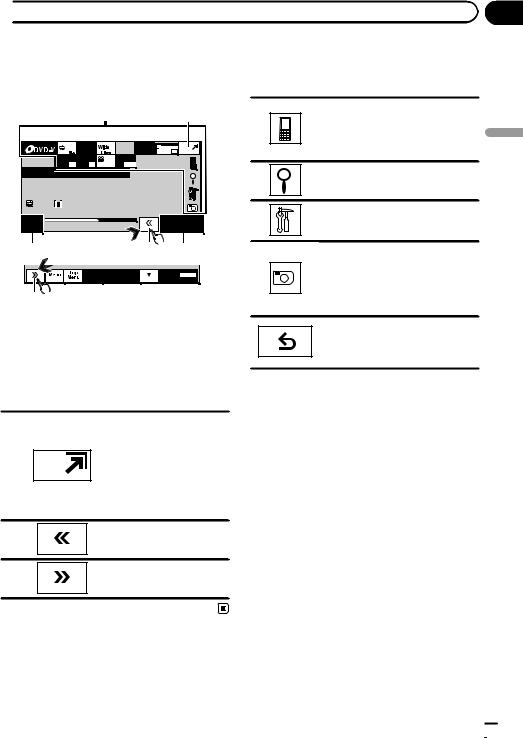
 Basic Operations
Basic Operations
Activating the touch panel |
Common operations for |
keys |
menu settings/lists |
Section
04 |
1 1
Wed 28 may
12:45 PM |
01 01 01 L+R
Abcdeabcdeabcdeabcdeab
8 |
|
12 |
01:45 |
-02:45 |
1  2
2
 1
1
Return
3
(AVH-P5200BT only)
Starting the Bluetooth telephone menu.
Refer to Introduction of Bluetooth telephone operations on page 25.
Displaying the list menu. Starting the search function.
Displaying the menu.
Refer to Introduction of menu operations on page 54.
Displaying still images as a slide show when listening to another source.
Viewing slide shows
Refer to Introduction of still image playback operations on page 23.
Operations Basic
1Touch panel keys
Perform various operations by touching the panel.
2Open/close keys
Control the touch panel key area by touching these keys.
Turning the display to simplified display.
Returning to the normal display by touching the screen
1 when playing moving images.
Returning to the normal display by touching same icon when playing audio.
2 |
Viewing the hidden touch |
|
panel keys. |
||
|
3
Shorten the touch panel area.
Returning to the previous display Returning to the previous list/category (the folder/category one level higher)
!Press and hold MENU to display
Picture Adjustment.
Refer to Changing the picture adjustment on page 69.
Opening and closing the LCD panel
The LCD panel will open or close automatically when the ignition switch is turned on or off. You can turn off the automatic close/open function. (Refer to page 9.)
!Do not close the LCD panel by force with your hands. That will cause a malfunction.
!The automatic close/open function will operate the display as follows.
—When the ignition switch is turned OFF while the LCD panel is opened, the LCD panel will close after six seconds.
—When the ignition switch is turned ON again (or turned to ACC), the LCD panel will open automatically.
En  13
13
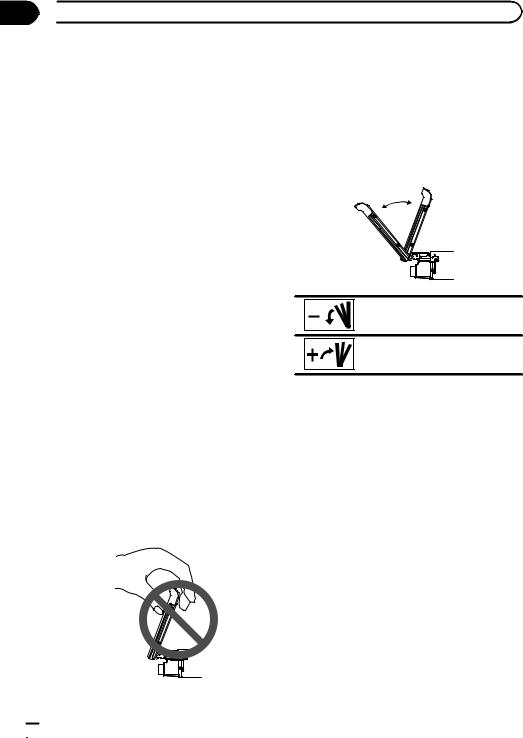
Section
04  Basic Operations
Basic Operations
—Removing or attaching the front panel will automatically close or open the LCD panel. (Refer to page 64.)
!When the ignition switch is turned OFF after the LCD panel has been closed, turning the ignition switch ON again (or turning it to ACC) will not open the LCD panel. In this case, press OPEN/CLOSE to open the LCD panel.
!When closing the LCD panel, check to make sure that it has closed completely. If the LCD panel has stopped halfway, leaving it like this could result in damage.
 CAUTION
CAUTION
Keep hands and fingers clear of the unit when opening, closing, or adjusting the LCD panel. Be especially cautious of children’s hands and fingers.
% Press OPEN/CLOSE to open the LCD panel.
# To close the LCD panel, press OPEN/CLOSE again.
Adjusting the LCD panel angle
 Important
Important
!If you can hear the LCD panel knocking against your vehicle’s console or dashboard, touch the TILT keys to move the LCD panel a little forward.
!When adjusting the LCD panel angle, be sure to touch the TILT keys. Forcibly adjusting the LCD panel by hand may damage it.
1 Display the system menu.
Refer to Introduction of menu operations on page 54.
2Touch TILT.
3Touch the TILT keys to adjust the LCD panel to an easily viewable angle.
The LCD panel angle continues changing as long as you touch and hold the TILT keys.
Laying the panel down.
Returning the panel to the upright position.
# As the set angle is saved, the LCD panel will automatically be adjusted to the same position the next time the LCD panel is opened.
Turning the LCD panel horizontally
When the LCD panel is upright and hinders the operation of the air conditioner, the panel can be turned horizontally temporarily.
% Press and hold OPEN/CLOSE to turn the LCD panel horizontally.
#To return to the original position, press and hold OPEN/CLOSE again.
#The LCD panel returns to the original position
automatically, indicated with a beeping sound 10 seconds after operation.
Ejecting a disc
1Press h (eject).
2Eject a disc
 14
14 En
En

 Basic Operations
Basic Operations
Ejecting an SD
1 Removing the front panel
Refer to Removing the front panel on page 9.
2Push an SD.
3Ejecting an SD
Setting the clock
1Switch to Clock Adjustment display.
Refer to Basic Operations on page 11.
2Select the item to set.
3Touch a or b to set the correct date and time.
Section
04 |
Operations Basic
En  15
15
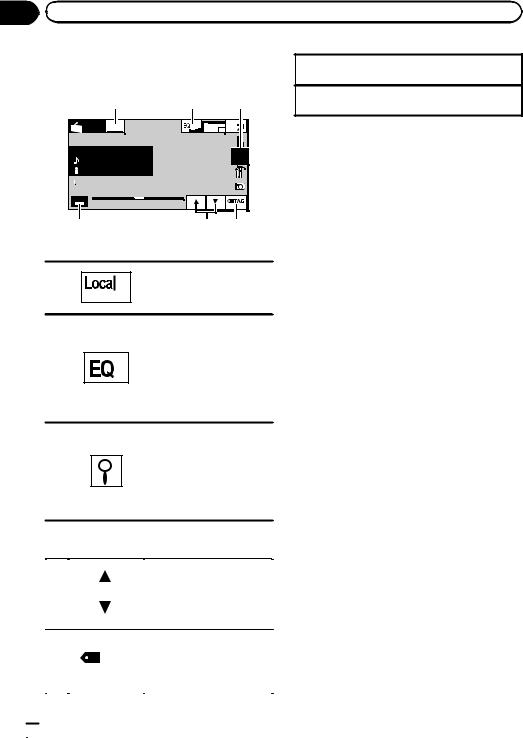
Section |
|
05 |
Tuner |
Introduction of tuner operations
1 2 3
Radio |
Local |
Wed 28 may |
12:45 PM |
|
|
Abcdeabcdeabcde |
|
|
|
|
|||||
|
|
Abcdeabcdeabcde |
|
|
87.5 |
|
|||||
|
|
|
|
|
|||||||
|
|
Abcdeabcdeabcde |
|
|
|
|
|||||
|
|
MHz |
|||||||||
|
|
|
|
|
|
|
|
|
|
|
|
P.ch |
2 |
|
|
|
|
|
|
|
|
||
|
|
|
|
|
|
|
|
|
|
|
|
|
Band: |
|
|
|
|
|
|
|
|
|
|
|
|
|
|
|
|
|
|
|
|
||
|
|
|
|
|
|
|
|
|
|
|
|
|
FM1 |
|
87.5 MHz |
|
|
|
|
||||
Manual tuning (step by step) using the buttons 1 Press c or d (TRACK).
Seek tuning using the buttons
1 Press and hold c or d (TRACK).
 Note
Note
Listening AM radio while an iPod is charged from this unit may generate noise. In this case, disconnect the iPod from this unit.
4 |
5 |
6 |
1 Touch panel keys
1
2
3
Turning local seek tuning on and off.
Refer to Tuning in to strong signals on page 33.
Switching the equalizer curves.
Refer to Using the equalizer on page 55.
Touch and hold for more than two seconds to turn the auto-equalizer on or off. Refer to Using the autoequalizer on page 56.
Displaying the preset channel list.
Refer to Storing and recalling stations on page 33.
Refer to Storing the strongest stations on page 33.
Refer to Storing and recalling stations on page 33.
4 |
|
Band: |
|
|
Selecting a band (FM1, FM2, |
|
|
|
|
FM3 for FM or AM). |
|
|
|
|
|
|
|
|
|
|
|
|
|
|
|
|
|
|
|
|
|
|
|
|
Recalling radio station fre- |
|
|
|
|
|
|
|
|
|
|
|
quencies assigned to preset |
5 |
|
|
|
|
tuning keys. |
|
|
|
|||
|
|
|
|
|
Refer to Storing and recalling |
|
|
|
|
|
stations on page 33. |
|
|
|
|
|
|
|
|
|
|
|
|
|
|
|
|
|
Saving song information |
|
|
TAG |
|
(tag) from the broadcasting |
|
6 |
|
|
station to your iPod. |
||
|
|
|
|
|
Refer to Using iTunes tagging |
|
|
|
|
|
on page 34. |
|
|
|
|
|
|
 16
16 En
En
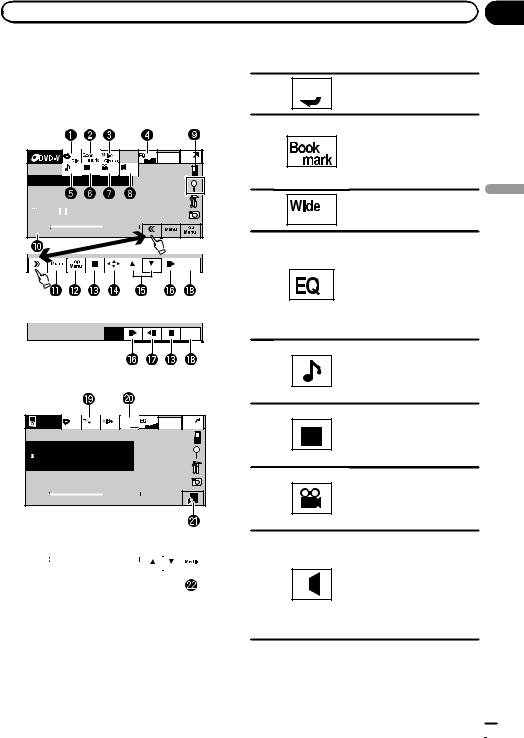
|
Section |
Playing moving images |
06 |
Introduction of video playback operations
You can view DVD/DVD-R/DVD-RW/CD/CD-R/ CD-RW/USB/SD/iPod.
|
|
|
Wed 28 may |
|
|
|
12:45 PM |
01 |
01 |
01 |
L+R |
Abcdeabcdeabcdeabcdeab |
|
||
 8
8  12
12
|
|
|
|
01:45 |
-02:45 |
|
|
|
|
|
|
|
|
|
|
Return
DVD video
Return
Video CD
iPod |
|
|
S.Rtrv |
Wed 28 may |
|
|
12:45 PM |
||
ALL |
Songs |
|
 Abcdeabcdeabcdeabcdeab
Abcdeabcdeabcdeabcdeab
Abcdeabcdeabcdeabcdeab
 Abcdeabcdeabcdeabcdeab
Abcdeabcdeabcdeabcdeab
2067/12345
|
|
|
|
01:45 |
-02:45 |
|
|
|
|
|
|
|
|
|
|
iPod video
|
|
|
|
|
|
|
|
|
|
|
|
01:45 |
-02:45 |
|
|
|
|
|
|
|
|
|
|
|
|
|
When playing a disc containing a mixture of various media file types
!If an iPod with video capabilities is connected to this unit using an interface cable such as the CD-IU50V (sold separately), you can enjoy the video contents of the iPod as an iPod source.
1 Touch panel keys
Selecting the repeat range.
1  Refer to Repeating playback on page 36.
Refer to Repeating playback on page 36.
During playback, touch the point at which you want to re-
2 sume playback the next time the disc is loaded.
Refer to Resume playback (Bookmark) on page 37.
Changing the screen mode.
3 Refer to Changing the wide screen mode on page 41.
Switching the equalizer curves.
Refer to Using the equalizer on page 55.
4 Touch and hold for more than two seconds to turn the auto-equalizer on or off. Refer to Using the autoequalizer on page 56.
Switching between audio languages during playback.
5 Refer to Changing audio language during playback (Multiaudio) on page 38.
Switching between subtitle languages during playback.
6 Refer to Changing the subtitle language during playback (Multi-subtitle) on page 38.
Switching among viewing angles during playback.
7 Refer to Changing the viewing angle during playback (Multi-angle) on page 39.
Switching the audio output, when playing video discs recorded with LPCM audio.
Refer to Selecting audio out-
8  put on page 39. Switching between stereo
put on page 39. Switching between stereo
and monaural audio output, when playing Video CD discs.
images moving Playing
En  17
17
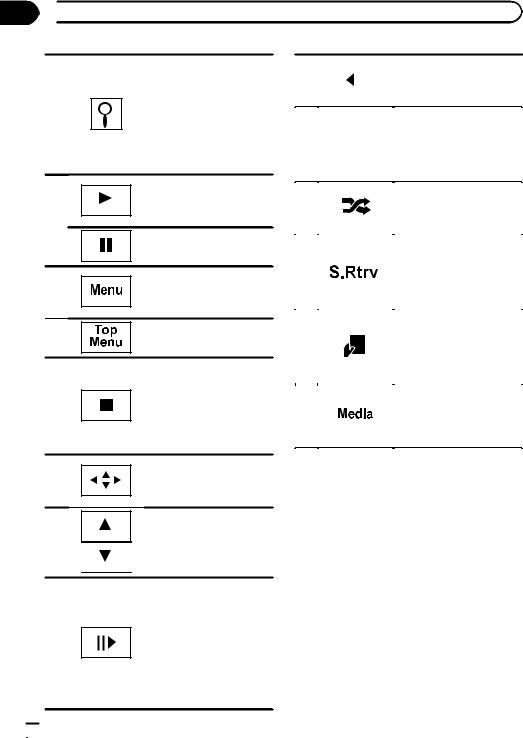
Section
06  Playing moving images
Playing moving images
9
a
b
c
d
e
f
g
 18
18 En
En
Starting the search function. Refer to Searching for the part you want to play on page 38. Refer to Selecting files from the file name list on page 40. Displaying iPod menus. Refer to Playing videos from your iPod on page 36 and
Browsing for a video/music on the iPod on page 36.
Returning to normal playback during paused, slow motion, or frame-by-frame playback.
Pausing playback
Displaying the DVD menu during DVD playback. Refer to Operating the DVD menu on page 35.
Returning to the top menu during DVD playback.
Stopping playback. Stopping playback at the point set in Resume playback.
Touch one more time to stop playback completely.
Refer to Resume playback (Bookmark) on page 37.
Displaying arrow keys to operate the DVD menu.
Refer to Using the arrow keys on page 35.
Skipping to another title. Selecting a folder during DivX file playback.
Moving ahead one frame at a time during playback.
Refer to Frame-by-frame playback on page 37.
Touch and hold for more than two seconds to slow down playback speed.
Speeding up the playback speed in four steps during slow motion playback on DVD video/Video CD.
|
|
|
|
Speeding down the playback |
|
|
|
|
|
h |
|
|
|
speed in four steps, during |
|
|
|
||
|
|
|
slow motion playback on |
|
|
|
|
|
|
|
|
|
|
Video CD. |
|
|
|
|
|
|
|
|
|
|
|
|
|
|
|
|
|
Returning to the specified |
|
|
|
|
|
|
|
scene to which the DVD cur- |
i |
|
|
|
Return |
|
rently being played has been |
|
|
|
|
|
preprogrammed to return. |
|||
|
|
|
|
|
|
|
|
|
|
|
|
|
|
|
Refer to Return to the speci- |
|
|
|
|
|
|
||
|
|
|
|
|
|
|
fied scene on page 39. |
|
|
|
|
|
|
|
|
|
|
|
|
|
|
|
Playing the video on your |
j |
|
|
|
|
|
|
iPod in a random order. |
|
|
|
|
|
|
Refer to Random play (shuf- |
|
|
|
|
|
|
|
|
|
|
|
|
|
|
|
|
fle) on page 35. |
|
|
|
|
|
|
||
|
|
|
|
|
|
|
|
|
|
|
|
|
|
|
Switching the Advanced |
|
|
|
|
|
|
|
sound retriever function set- |
k |
|
|
|
|
|
|
ting when playing a video on |
|
|
|
|
|
|
your iPod. |
|
|
|
|
|
|
|
|
|
|
|
|
|
|
|
|
Refer to Using advanced |
|
|
|
|
|
|
|
sound retriever on page 40. |
|
|
|
|
|
|
|
|
|
|
|
|
|
|
|
Conducting operation from |
|
|
|
|
|
|
|
your iPod and listening to it |
l |
|
|
|
|
|
|
using your car’s speaker’s. |
|
|
|
|
|
|
Refer to Operating this unit’s |
|
|
|
|
|
|
|
|
|
|
|
|
|
|
|
|
iPod function from your iPod |
|
|
|
|
|
|
|
|
|
|
|
|
|
|
|
on page 35. |
|
|
|
|
|
|
|
|
|
|
|
|
|
|
|
Switching between media |
|
|
|
|
|
|
|
file types to play on DVD/CD/ |
m |
|
|
|
|
|
|
USB/SD. |
|
|
|
|
|
|
|
Refer to Switching the media |
|
|
|
|
|
|
|
file type on page 34. |
|
|
|
|
|
|
|
|

|
Section |
Playing moving images |
06 |
Playing back videos
1Insert the disc into the disc loading slot with the label side up.
Playback will automatically start.
!If you are playing a DVD or Video CD, a menu may appear. Refer to Operating the DVD menu on page 35 and PBC playback on page 39.
!When the automatic playback function is on, the unit will skip the DVD menu and automatically start playback from the first chapter of the first
title. Refer to Automatic playback of DVDs on page 61.
1If a disc has already been inserted, press SRC/ OFF or touch the source icon to select the source.
!When the source icon is not displayed, it can be displayed by touching the screen.
!Disconnect headphones from the iPod before connecting to this unit.
!Depending on the iPod model and the amount of data stored in the iPod, it may take some time for playback to begin.
!Use the touch panel keys to select the iPod after connecting it to this unit.
!No Device is displayed when disconnecting the
iPod.
1If a message is displayed after loading a disc con-
taining DivX VOD content, touch Play.
Refer to Playing DivXÒ VOD content on page 40.
Ejecting a disc
1Refer to Ejecting a disc on page 14 or Ejecting an SD on page 15.
Selecting a chapter using the buttons 1 Press c or d (TRACK).
Fast forwarding or reversing using the buttons 1 Press and hold c or d (TRACK).
!Fast forward/fast rewind may not always be possible on some discs. In such cases, normal playback will automatically resume.
 Notes
Notes
!This DVD player can play back a DivX file recorded on CD-R/RW or DVD-R/RW. (Please see the following section for files that can be played back. Refer to page 84.)
!Do not insert anything other than a DVD (-R/- RW) or CD (-R/-RW) into the disc loading slot.
!If the bookmark function is on, DVD playback resumes from the selected point. For more de-
tails, refer to Resume playback (Bookmark) on page 37.
!Some operations may not be available while watching a DVD due to the programming of
the disc. In such cases, the  icon appears on the screen.
icon appears on the screen.
!To ensure proper operation, connect the dock connector cable from the iPod directly to this unit.
!If the ignition switch is set to ACC or ON, the iPod battery will be charged while connected. However, the iPod battery is not charged when you select an SD as the source.
!While the iPod is connected to this unit, the iPod cannot be turned on or off.
However, the iPod can be turned on or off when you select an SD as the source.
images moving Playing
En  19
19
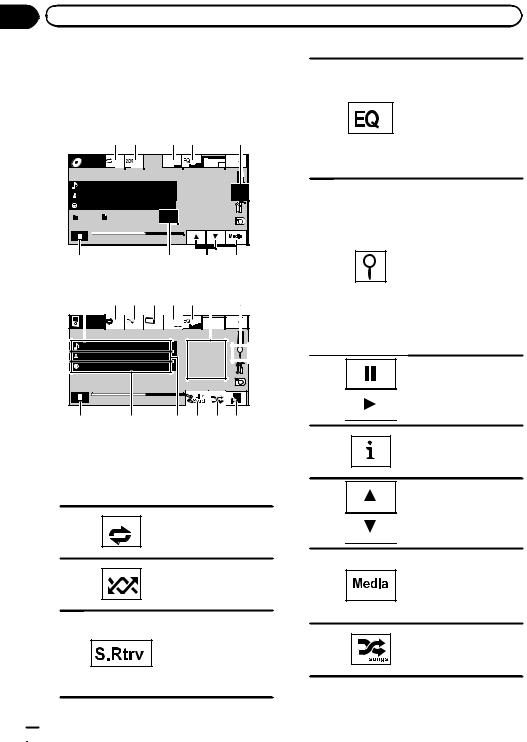
Section |
|
|
|
|
|
|
|
07 |
Playing audio |
|
|
|
|
||
|
Introduction of sound |
|
|
Switching the equalizer |
|||
|
playback operations |
|
|
curves. |
|||
|
|
|
Refer to Using the equali- |
||||
|
|
|
|
|
|
|
|
|
You can listen to DVD-R/DVD-RW/CD/CD-R/ |
|
zer on page 55. |
||||
|
CD-RW/USB/SD/iPod sound files. |
|
4 |
Touch and hold for more |
|||
|
|
than two seconds to turn |
|||||
|
|
|
|
|
|
|
|
|
|
1 2 |
3 4 |
|
5 |
|
the auto-equalizer on or |
|
|
|
|
|
|
|
off. |
|
ROM |
|
S.Rtrv |
Wed 28 may |
|
|
Refer to Using the auto- |
|
ALL Songs |
|
12:45 PM |
|
|
equalizer on page 56. |
|
|
|
|
|
|
|
|
|
|
Abcdeabcdeabcdeabcdeab |
|
|
|
Displaying a list of track |
||
|
Abcdeabcdeabcdeabcdeab |
|
|
|
|||
|
|
|
|
titles/file names to select |
|||
|
Abcdeabcdeabcdeabcdeab |
|
|
|
|||
|
|
|
|
songs on a CD. |
|||
|
87 |
125 |
|
|
|
|
|
|
|
|
|
|
Refer to Selecting tracks |
||
|
|
|
|
|
|
|
|
|
01:45 |
|
-02:45 |
|
|
|
from the track title list on |
|
|
|
|
|
page 39. |
||
|
|
|
|
|
|
|
|
|
6 |
|
7 |
8 |
9 |
|
Displaying the file name |
|
CD |
|
|
|
|
5 |
list to select the files. |
|
|
|
|
|
|
Refer to Selecting files |
|
|
f |
1 a b 3 4 i |
5 |
|
from the file name list on |
||
|
|
page 40. |
|||||
|
|
|
S.Rtrv |
|
|
|
Displaying iPod menus. |
|
iPod |
|
Wed 28 may |
|
|
Refer to Browsing for a |
|
|
ALL Songs |
|
12:45 PM |
|
|
||
|
|
|
|
|
|
|
video/music on the iPod |
|
Abcdeabcdeabcdeabcdeab |
|
|
|
on page 36. |
||
|
Abcdeabcdeabcdeabcdeab |
|
|
|
|
||
|
Abcdeabcdeabcdeabcdeab |
|
|
|
|
||
|
2067/12345 |
|
|
|
|
Pausing and starting |
|
|
|
|
|
|
|
6 |
|
|
|
|
|
|
|
playback |
|
|
01:45 |
|
-02:45 |
|
|
|
|
|
6 |
h |
g c d e |
|
|
||
iPod audio
7
You can control an iPod with this unit by using
a cable such as the CD-IU50 (sold separately).
1 Touch panel keys
1
2
3
 20
20 En
En
Selecting the repeat |
8 |
range. |
|
|
Refer to Repeating play- |
|
|
back on page 36. |
|
|
Playing songs in random |
|
|
order. |
9 |
|
Refer to Random play |
||
|
||
(shuffle) on page 35. |
|
|
|
|
|
Switching the Advanced |
|
|
sound retriever function |
|
|
setting when playing |
a |
|
audio. |
||
|
||
Refer to Using advanced |
|
|
sound retriever on page |
|
|
40. |
|
Switching the text information to display on this unit when playing MP3/ WMA/AAC files.
Selecting a folder.
Switching between media file types on a DVD/CD/USB/SD. Refer to Switching the media file type on page 34.
Playing songs on the iPod in random order. Refer to Random play (shuffle) on page 35.

|
Section |
Playing audio |
07 |
Changing the speed of audiobook playback on
b the iPod.
Refer to Changing audiobook speed on page 40.
Switching to Link Search mode to play songs related to the currently
c
playing song on the iPod. Refer to Displaying lists related to the currently playing song (Link Search) on page 40.
|
|
|
Playing all songs on the |
|
|
|
iPod in random order. |
d |
|
|
Refer to Playing all songs |
|
|
|
in random order (shuffle |
|
|
|
|
|
|
|
all) on page 36. |
|
|
|
|
Conducting operation from your iPod and listening to it using your car’s
e speaker’s.
Refer to Operating this unit’s iPod function from your iPod on page 35.
2 Text information
Displaying the Songs list on the iPod.
f Refer to Searching for a video/music by category on page 36.
Displaying the Artists list on the iPod.
g Refer to Searching for a video/music by category on page 36.
Displaying the Albums list on the iPod.
h Refer to Searching for a video/music by category on page 36.
3 Artwork display
Starting Album Link Play on your iPod
iwhen you touch the artwork display. Refer to Displaying lists related to the cur-
rently playing song (Link Search) on page 40.
Playing back sound
1 Insert the disc into the disc loading slot with the label side up.
Playback will automatically start.
1If a disc has already been inserted, press SRC/ OFF or touch the source icon to select the source.
!When the source icon is not displayed, it can be displayed by touching the screen.
!Disconnect headphones from the iPod before connecting to this unit.
!Depending on the iPod model and the amount of data stored in the iPod, it may take some time for playback to begin.
!Use the touch panel keys to select the iPod after connecting it to this unit.
!No Device is displayed when disconnecting the iPod.
Ejecting a disc
1Refer to Ejecting a disc on page 14 or Ejecting an SD on page 15.
Selecting a track using the buttons 1 Press c or d (TRACK).
Fast forwarding or reversing using the buttons 1 Press and hold c or d (TRACK).
 Notes
Notes
!When playing back files recorded as VBR (variable bit rate) files, the play time will not be correctly displayed if fast forward or reverse operations are used.
!To ensure proper operation, connect the dock connector cable from the iPod directly to this unit.
!If the ignition switch is set to ACC or ON, the iPod battery will be charged while connected. However, the iPod battery is not charged when you select an SD as the source.
!While the iPod is connected to this unit, the iPod cannot be turned on or off.
However, the iPod can be turned on or off when you select an SD as the source.
!If the characters recorded on the disc are not compatible with this unit, those characters will not be displayed.
!Text information may not be correctly displayed depending on the recorded environment.
audio Playing
En  21
21

Section
07 Playing audio
Playing audio
!USB storage device that can be charged via USB will be recharged when plugged in and the ignition switch is set to ACC or ON.
However, the USB storage device that can be charged via USB will not be recharged when you select an SD as the source.
!Disconnect the USB portable audio player/ USB memory when you are done using it.
!When you select Clock or Speana on Select-
ing the background display on page 68, the artwork is not displayed.
 22
22 En
En
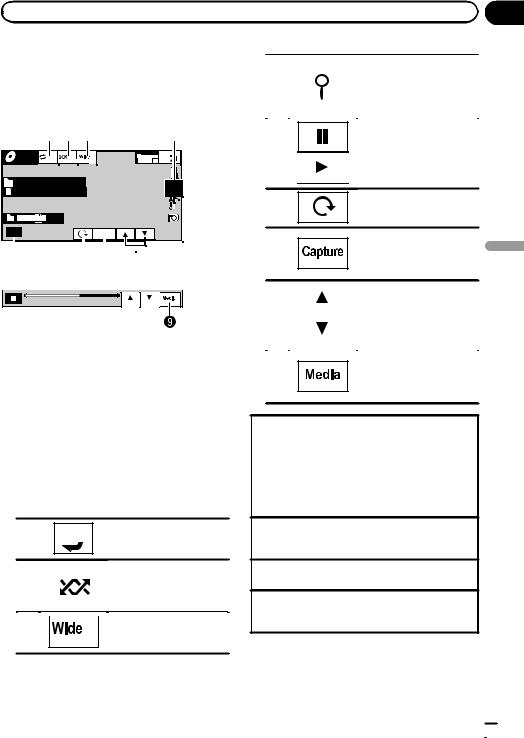
|
Section |
Playing still images |
08 |
Introduction of still image |
|
|
|
Displaying the file name |
playback operations |
|
|
|
list to select the files. |
4 |
|
|
Refer to Selecting files from |
|
|
|
|
||
You can view still images saved in CD-R/CD- |
|
|
|
the file name list on page |
|
|
|
||
RW/USB/SD. |
|
|
|
40. |
|
|
|
|
1 2 3 |
4 |
Photo |
|
|
Wed 28 may |
|
Off |
Full |
12:45 PM |
||
|
 Abcdeabcdeabcde
Abcdeabcdeabcde
Abcdeabcdeabcde
|
|
2 |
|
2 |
|
|
|
|
|
|
|
|
|
|
|
|
|
|
|
|
|
|
|
|
|
|
|
|
|
|
|
|
|
|
|
|
|
|
|
|
|
|
|
Capture |
|
|
|
|
|
|
|
|
|
|
|
|
|
||
|
|
|
|
|
|
|
|
||||
|
|
|
|
|
|
|
|
|
|
|
|
5 |
6 7 |
8 |
|||||||||
CD
01:45 |
-02:45 |
When playing a disc containing a mixture of various media file types
When loading a CD-R/RW/USB/SD containing JPEG picture files, this unit starts a slideshow from the first folder/picture on the disc/device. The player displays the pictures in each folder in alphabetical order.
The table below shows the controls for viewing a slideshow.
1Touch panel keys
Touch any of the following touch panel keys to select the function to be adjusted.
Selecting the repeat range.
1  Refer to Repeating playback on page 36.
Refer to Repeating playback on page 36.
|
|
|
|
|
Playing files in a random |
|
|
|
|
||
2 |
|
|
|
|
order. |
|
|
|
|
Refer to Random play (shuf- |
|
|
|
|
|
|
|
|
|
|
|
|
fle) on page 35. |
|
|
|
|
||
|
|
|
|
|
|
|
|
|
|
|
Changing the screen mode |
|
|
|
|
|
3Refer to Changing the wide screen mode on page 41.
5 |
Starting or pausing the sli- |
|
deshow. |
||
|
6Rotating the displayed picture 90° clockwise
Capturing an image in
7JPEG files.
Refer to Capture an image in JPEG files on page 41.
8 |
|
Selecting a folder. |
|
||
|
|
|
|
|
|
Switching between media
9
file types.
Refer to Switching the media file type on page 34.
Playing still images
1Insert the disc into the disc loading slot with the label side up.
Playback will automatically start.
1If a disc has already been inserted, press SRC/ OFF or touch the source icon to select the source.
!When the source icon is not displayed, it can be displayed by touching the screen.
Ejecting a disc
1Refer to Ejecting a disc on page 14 or Ejecting an SD on page 15.
Selecting a file using the buttons 1 Press c or d (TRACK).
Fast file searching
1 Press and hold c or d (TRACK).
!You can search 10 JPEG files at a time.
images still Playing
En  23
23

Section
08  Playing still images
Playing still images
 Notes
Notes
!This unit can play back a JPEG file recorded on CD-R/RW/ROM/SD/USB storage device. (Please see the following section for files that can be played back. Refer to page 84.)
!Files are played back in file number order and folders are skipped if they contain no files. (If
folder 01 (ROOT) contains no files, playback commences with folder 02.)
Introduction of still image playback as a slideshow operations
You can view still images saved in CD-R/CD- RW/USB/SD as a slideshow when listening to another source.
1 2 3 |
4 |
5 |
|||||||
|
|
|
|
|
|
|
|
|
|
|
|
|
|
|
|
|
|
|
|
|
|
|
Off |
|
|
Full |
|
|
|
|
|
|
|
||||||
|
|
|
|
|
|
|
|
|
|
|
|
|
|
|
|
|
|
|
|
|
|
|
|
|
|
|
|
|
|
|
|
|
|
|
|
|
|
|
|
|
|
|
|
|
Capture |
|
|
|
|
|
|
||
6 |
7 8 |
|||||
The table below shows the controls for viewing a slideshow.
1Touch panel keys
Touch any of the following touch panel keys to select the function to be adjusted.
Selecting the repeat range.
1  Refer to Repeating playback on page 36.
Refer to Repeating playback on page 36.
Playing files in a random
2
order.
Refer to Random play (shuffle) on page 35.
Changing the screen mode
3  Refer to Changing the wide screen mode on page 41.
Refer to Changing the wide screen mode on page 41.
4 |
|
|
|
|
Selecting a folder. |
|
|
|
|
||
|
|
|
|
|
|
|
|
|
|
|
|
|
|
|
|
|
|
|
|
|
|
|
|
5Selecting a file.
6Starting or pausing the slideshow.
7Rotating the displayed picture 90° clockwise
Capturing an image in
8JPEG files.
Refer to Capture an image in JPEG files on page 41.
1 Start slideshow when listening to another source.
Refer to Common operations for menu settings/lists on page 13.
Displaying still images as a slide show.
2 Select the device containing the files that you want to display.
!Disc – Built-in DVD player
!USB – USB
!SD – SD memory card
#To cancel searching, touch Cancel.
 Notes
Notes
!When the USB or SD source is selected, this unit cannot view still images on USB/SD as a slideshow.
!When MW/LW band is selected, this unit cannot view still images as a slideshow.
 24
24 En
En
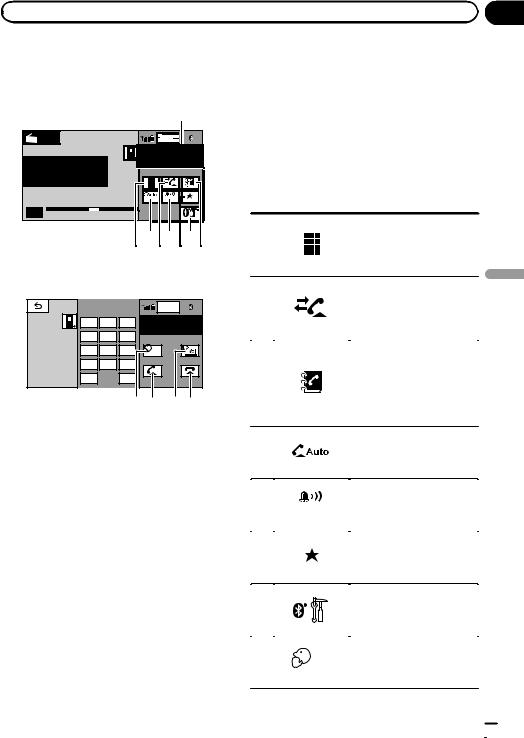
|
Section |
Bluetooth Telephone |
09 |
Introduction of Bluetooth telephone operations
1
Radio |
Wed 28 may |
|
|
12:45 |
PM |
1 |
|
Abcdeabcdeabcde
 Abcdeabcdeabcde
Abcdeabcdeabcde
 Abcdeabcdeabcde
Abcdeabcdeabcde
P.CH2
Off On
Band:
FM1 |
87.5 MHz |
4 5 7
1 2 6 3
Telephone standby display
|
|
|
Wed 28 may |
|
|
|
|
12:45 PM |
1 |
1 |
2 |
3 |
ABCDEHGHI 01 |
|
|
|
|||
|
|
|
012345678901 |
|
4 |
5 |
6 |
|
|
7 |
8 |
9 |
Off |
|
* |
0 |
# |
|
|
|
|
|
|
|
+ |
|
C |
|
|
|
|
|
8 a 9b |
|
When switching to the entering phone number mode
You can use Bluetooth telephone (AVH-P5200BT only).
 Important
Important
!Since this unit is on standby to connect with your cellular phone via Bluetooth wireless technology, using it without the engine running can drain the battery power.
!Advanced operations that require attention such as dialing numbers on the monitor, etc., are prohibited while driving. Park your vehicle in a safe place when using these advanced operations.
!Operations available may be limited depending on the cellular phone connected to this unit.
!Be sure to park your vehicle in a safe place and apply the parking brake when performing this operation.
1Incoming call notice
Indicates that an incoming call has been received and has not been checked yet.
!Not displayed for calls made when your cellular phone is disconnected from this unit.
2Touch panel keys
|
|
|
|
Switching the mode to enter |
|
|
|
|
the phone number directly. |
1 |
|
|
|
Refer to Making a call by en- |
|
|
|
|
tering phone number on page |
|
49. |
|||
|
|
|
|
|
|
|
|
|
Switching to the call history |
|
|
|
|
list. |
2 |
|
|
|
Refer to Using the missed, re- |
|
|
|
|
ceived and dialed call lists on |
|
|
|
|
page 48. |
|
|
|
|
|
|
|
|
|
Switching to the phone book |
|
|
|
|
mode. |
|
|
|
|
Refer to Calling a number in |
3 |
|
|
|
the phone book on page 47. |
|
|
|
|
Refer to Selecting a number |
|
|
|
|
by alphabet search mode on |
|
|
|
|
page 47. |
|
|
|
|
|
|
|
|
|
Turning automatic answering |
4 |
|
|
|
on or off. |
|
|
|
Refer to Setting automatic an- |
|
|
|
|
|
|
|
|
|
|
swering on page 49. |
|
|
|
|
|
|
|
|
|
|
|
|
|
|
Turning the ring tone for in- |
5 |
|
|
|
coming calls on or off. |
|
|
|
Refer to Switching the ring |
|
|
|
|
|
|
|
|
|
|
tone on page 49. |
|
|
|
|
|
|
|
|
|
|
|
|
|
|
Displaying the preset dial |
6 |
|
|
|
screen. |
|
|
|
Refer to Using the preset dial |
|
|
|
|
|
|
|
|
|
|
lists on page 49. |
|
|
|
|
|
|
|
|
|
|
|
|
|
|
Displaying the Bluetooth |
7 |
|
|
|
connection menu. |
|
|
|
Refer to the instructions |
|
|
|
|
|
|
|
|
|
|
from page 50 to page 52. |
|
|
|
|
|
|
|
|
|
|
|
|
|
|
Turning private mode on or |
8 |
|
|
|
off. |
|
|
|
Refer to Setting the private |
|
|
|
|
|
|
|
|
|
|
mode on page 50. |
|
|
|
|
|
|
|
|
|
|
Telephone Bluetooth
En  25
25
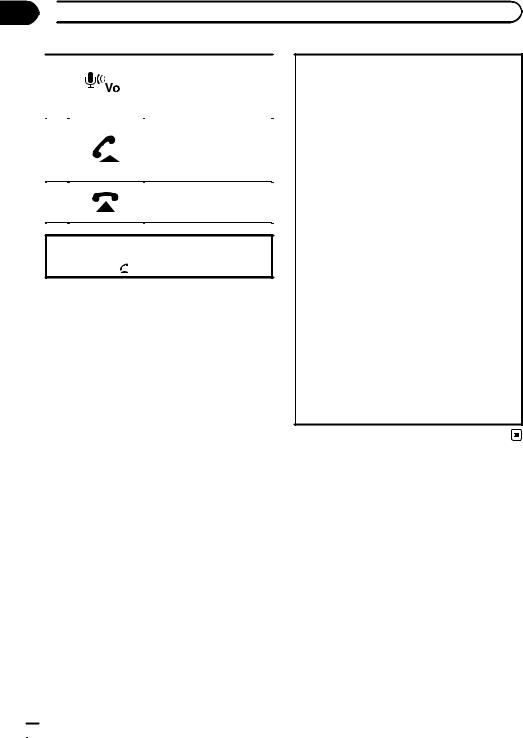
Section
09  Bluetooth Telephone
Bluetooth Telephone
|
|
|
|
|
|
|
Adjusting the other party’s |
|
|
|
|
|
|
|
listening volume. |
9 |
|
|
|
|
|
|
Refer to Adjusting the other |
|
|
|
|
|
|||
|
|
|
|
|
|
|
party’s listening volume on |
|
|
|
|
|
|
|
page 49. |
|
|
|
|
|
|
|
|
|
|
|
|
|
|
|
Accepting an incoming call. |
|
|
|
|
|
|
|
Making a phone call, when |
a |
|
|
|
|
|
|
selecting a phone number. |
|
|
|
|
|
|
|
Switching between callers on |
|
|
|
|
|
|
|
hold. |
|
|
|
|
|
|
|
|
|
|
|
|
|
|
|
Ending a call. |
|
|
|
|
|
|
|
|
b |
|
|
|
|
|
|
Rejecting an incoming call. |
|
|
|
|
|
|
|
Canceling call waiting. |
|
|
|
|
|
|
|
|
Accepting an incoming call Ending a call
1 Press MUTE/ .
 Notes
Notes
!Private mode can only be operated while you are talking on the phone.
!To end the call, both you and the other caller must hang up your phones.
Setting up for hands-free phoning
Before you can use the hands-free phoning function you must set up the unit for use with your cellular phone. This entails establishing a Bluetooth wireless connection between this unit and your phone, registering your phone with this unit, and adjusting the volume level.
1Connection
First, you need to connect a Bluetooth telephone to this unit.
For detailed instructions on connecting your phone to this unit via Bluetooth wireless technology, see following section. Using a Bluetooth device to pair on page 51 and Pairing from this unit on page 50.
!You may also need to enter a PIN code into this unit. If your telephone requires a PIN code to establish a connection, look for the code on the telephone or in its accompanying documentation. Refer to Entering PIN code for Bluetooth wireless connection on page 52.
2Volume adjustment
Adjust the earpiece volume of your cellular phone to your preference. The unit will record the adjusted volume level as the default setting.
!The volume of the caller’s voice and ring tone may vary depending on the type of cellular phone.
!If there is a large volume difference between the ring tone and caller’s voice, the overall volume level may become unstable.
!Make sure to adjust the volume to a proper level before disconnecting the cellular phone from the unit. If the volume is muted (zero level) on your cellular phone, the volume level of your cellular phone remains muted even after the cellular phone is disconnected.
 26
26 En
En

XM/SIRIUS tuner |
|
|
||
Introduction of XM/SIRIUS |
these points. For all other information on |
|||
tuner operations |
|
|
using the SIRIUS tuner, please refer to the SIR- |
|
|
|
IUS operation manual. |
||
|
|
|
|
|
1 2 3 |
4 |
5 |
! With this unit, you can operate one addi- |
|
|
|
|
|
tional function: XM/SIRIUS channel direct |
Mode |
Memo Team |
|
Wed 28 may |
selection. Refer to Selecting an XM/SIRIUS |
SIRIUS All CH |
Off Off |
|
12:45 PM |
|
|
|
|||
|
|
|
|
channel directly on page 43. |
Abcdeabcdeabcde |
CH183 |
1 Touch panel keys |
Abcdeabcdeabcde |
P.CH2 |
|
|
|
|
|
|
Mode |
Selecting a channel by num- |
Band: |
|
|
|
|
|
|
All CH |
ber or category. |
|
CH183 |
|
|
|
|
|
1 |
Refer to Switching the XM/ |
|
|
|
|
|
|
|
||
6 7 |
|
|
|
|
|
Mode |
SIRIUS channel selection |
|
|
|
|
|
|
Category |
mode on page 42. |
||
|
|
Instant |
Memo |
Memo Game |
Team |
Memo |
|
|
|
|
Replay |
Edit |
Info |
Setting |
|
|
|
|
|
|
|
|
||||
|
8 |
9 a b c d |
On |
Tuning the MyMix function |
||||
|
on or off for the SIRIUS tuner. |
|||||||
|
2 |
|||||||
|
|
|
|
|
|
|
Refer to Turning the MyMix |
|
SIRIUS tuner |
|
|
|
|
|
Memo |
||
|
|
|
|
|
function on or off. on page 44. |
|||
|
|
|
|
|
|
|
Off |
|
|
1 |
|
4 |
|
5 |
|
||
|
|
|
|
|
||||
XM |
XM Mode |
|
|
|
Wed 28 may |
|
Team |
|
|
All CH |
|
|
|
12:45 PM |
|
|
|
|
|
|
|
|
|
|
||
Abcdeabcdeabcde |
|
|
|
|
|
On |
Turning the Game Alert on or |
|
Abcdeabcdeabcde |
CH183 |
off for the SIRIUS tuner. |
||||||
|
|
3 |
||||||
Abcdeabcdeabcde |
Refer to Switching the Game |
|||||||
Abcdeabcdeabcde |
Team |
|||||||
|
|
|
|
|
|
|
Alert on or off on page 45. |
|
P.ch 2 |
|
|
|
|
|
|
Off |
|
Band: |
|
|
|
|
|
|
|
|
XM |
CH183 |
|
|
|
|
|
|
Switching the equalizer |
|
|
|
|
|
|
|
|
|
6 |
|
|
|
|
|
|
|
curves. |
|
|
|
|
|
|
|
|
Refer to Using the equalizer |
|
|
|
|
|
|
Memo |
|
on page 55. |
|
|
|
|
|
Memo |
4 |
Touch and hold for more |
|
|
|
|
|
|
Edit |
|||
|
|
|
|
|
|
|||
|
|
|
8 |
a b |
|
than two seconds to turn the |
||
|
|
|
|
auto-equalizer on or off. |
||||
XM tuner |
|
|
|
|
|
|
Refer to Using the auto- |
|
|
|
|
|
|
|
equalizer on page 56. |
||
|
|
|
|
|
|
|
|
|
Section
10 |
tuner XM/SIRIUS
You can use this unit to control an XM satellite |
|
|
|
Displaying the preset chan- |
digital tuner (GEX-P920XM), which is sold se- |
|
|
|
|
|
|
|
nel list. |
|
parately. |
|
|
|
Refer to Storing and recalling |
For details concerning operation, refer to the |
|
|
|
stations on page 33. |
|
|
|
Selecting a channel directly. |
|
XM tuner’s operation manuals. This section |
|
|
|
Refer to Selecting an XM/SIR- |
provides information on XM operations with |
5 |
|
|
IUS channel directly on page |
|
|
43. |
||
this unit which differs from that described in |
|
|
|
Selecting a channel from the |
the XM tuner’s operation manual. |
|
|
|
XM channel list. |
When the SIRIUS tuner is used together with |
|
|
|
Refer to Selecting a channel |
this unit, some operations differ slightly from |
from the XM channel list dis- |
|
play on page 42. |
||
those described in the SIRIUS operation man- |
||
|
||
|
||
ual. This manual provides information on |
|
En  27
27

Section
10  XM/SIRIUS tuner
XM/SIRIUS tuner
|
|
|
|
|
|
|
Selecting a band (XM1, XM2 |
|
|
|
|
Band: |
|
|
or XM3) for XM tuner. |
6 |
|
|
|
|
|
|
Selecting a band (SIRIUS1, |
|
|
|
|
|
|
|
SIRIUS2 or SIRIUS3) for the |
|
|
|
|
|
|
|
SIRIUS tuner. |
|
|
|
|
|
|
|
|
|
|
|
|
|
|
|
Recalling radio station fre- |
|
|
|
|
|
|
|
quencies assigned to preset |
|
|
|
|
|
|
|
tuning keys. |
|
|
|
|
|
|
|
Refer to Storing and recalling |
|
|
|
|
|
|
|
stations on page 33. |
|
|
|
|
|
|
|
Selecting the channel cate- |
8 |
|
|
|
|
|
|
gory when selecting Mode |
|
|
|
|
|
|
||
|
|
|
|
|
|
|
Category. |
|
|
|
|
|
|
|
Refer to Switching the XM/ |
|
|
|
|
|
|
|
SIRIUS channel selection |
|
|
|
|
|
|
|
|
|
|
|
|
|
|
|
mode on page 42 and Select- |
|
|
|
|
|
|
|
ing a SIRIUS channel from a |
|
|
|
|
|
|
|
channel category on page 42. |
|
|
|
|
|
|
|
|
|
|
|
|
|
|
|
Selecting a track, fast for- |
|
|
|
|
|
|
|
warding/reversing or paus- |
|
|
|
Instant |
|
|||
9 |
|
|
|
ing/playing for the SIRIUS |
|||
|
|
Replay |
|
tuner. |
|||
|
|
|
|
||||
|
|
|
|
|
|
|
Refer to Using the Instant Re- |
|
|
|
|
|
|
|
|
|
|
|
|
|
|
|
play function on page 46. |
|
|
|
|
|
|
|
|
|
|
|
|
|
|
|
Storing the song title and ar- |
|
|
|
|
|
|
|
|
a |
|
|
|
Memo |
|
tist name. |
|
|
|
|
|
||||
|
|
|
|
|
|
|
Refer to Making the MyMix |
|
|
|
|
|
|
|
playlist on page 43. |
|
|
|
|
|
|
|
|
|
|
|
|
|
|
|
|
|
|
|
|
|
|
|
Switching to memo edit |
|
|
|
|
|
|
|
mode. |
|
|
|
|
|
|
|
Refer to Setting up a song |
|
|
|
|
|
|
|
alert on page 44. |
|
|
|
|
Memo |
|
||
b |
|
|
|
|
Refer to Deleting a song from |
||
|
|
|
|||||
|
|
|
|
Edit |
|
the MyMix playlist for XM |
|
|
|
|
|
|
|
|
tuner on page 44. |
|
|
|
|
|
|
|
|
|
|
|
|
|
|
|
Refer to Deleting a song from |
|
|
|
|
|
|
|
the MyMix playlist for SIRIUS |
|
|
|
|
|
|
|
tuner on page 44. |
|
|
|
|
|
|
|
|
|
|
|
|
|
|
|
Displaying information on |
|
|
|
Game |
|
|||
c |
|
|
|
games for the SIRIUS tuner. |
|||
|
|
|
Info |
|
Refer to Displaying game in- |
||
|
|
|
|
|
|||
|
|
|
|
|
|
|
formation on page 46. |
|
|
|
|
|
|
|
|
|
|
|
|
|
|
|
|
|
|
|
|
|
|
|
Selecting teams for game |
|
|
|
Team |
|
|||
d |
|
|
|
alert on the SIRIUS tuner. |
|||
|
Setting |
|
Refer to Selecting teams for |
||||
|
|
|
|||||
|
|
|
|
|
|
|
Game Alert on page 45. |
|
|
|
|
|
|
|
|
|
|
|
|
|
|
|
|
Switching the SIRIUS information.
Refer to Switching the SIRIUS display on
7page 46.
Touch and hold for more than two seconds to scroll the text.
Manual tuning (step by step) using the buttons 1 Press c or d (TRACK).
Seek tuning using the buttons
1 Press and hold c or d (TRACK).
 Note
Note
You can also perform tuning from a desired channel category. (Refer to Selecting a SIRIUS channel from a channel category on page 42.)
1 SIRIUS tuner information
 28
28 En
En
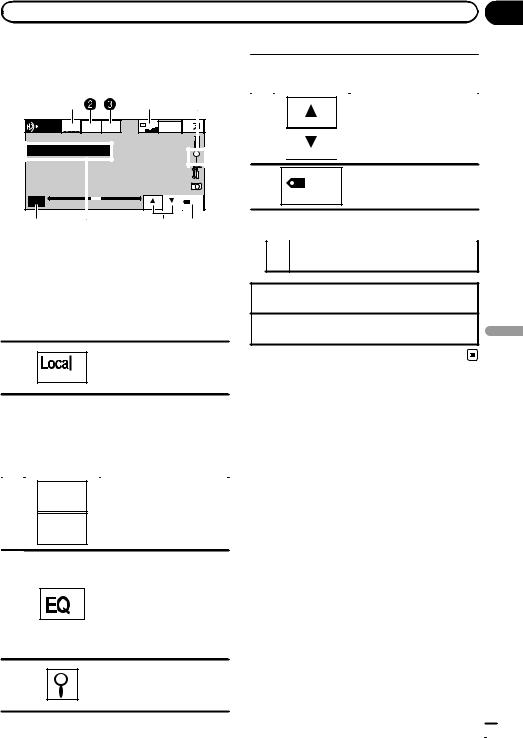
|
Section |
HD Radioä tuner |
11 |
Introduction of HD Radioä |
|
|
|
|
|
|
|
||
6 |
Band: |
Selecting a band (FM1, FM2, |
||
tuner operations |
||||
|
FM3 for FM or AM). |
|||
|
|
|||
|
|
|
|
|
|
1 |
|
|
4 |
5 |
|
|
Recalling radio station fre- |
Digital |
|
Seek |
Blending |
|
|
|
|
quencies assigned to preset |
|
Local |
Wed 28 may |
|
8 |
|
tuning keys. |
||||
Radio |
|
All |
D/AAuto |
12:45 PM |
|
|
|||
|
|
|
|
|
|
|
|
|
Refer to Storing and recalling |
Abcdeabcdeabcde |
|
87.9 |
|
|
|
stations on page 33. |
|||
|
|
|
|
|
|
|
|
|
|
P.CH2 |
|
|
|
|
MHz |
|
|
TAG |
Saving song information |
|
|
|
|
|
|
9 |
(tag) from the broadcasting |
||
|
|
|
|
|
|
|
|||
Band: |
|
|
|
|
|
TAG |
|
|
station to your iPod. |
FM1 |
87.9 MHz |
|
|
|
|
|
|
||
|
|
|
|
|
|
|
|
||
6 |
|
|
7 |
|
8 |
9 |
1 Digital Radio tuner information |
||
You can use this unit to control an HD Radio |
7 |
Switching the digital radio tuner informa- |
|
tuner (e.g. GEX-P20HD), which is sold sepa- |
|||
tion. |
|||
rately. |
|
|
|
|
|
For details concerning operation, refer to the HD Radio tuner’s operation manual.
1 Touch panel keys
Turning local seek tuning on 1 or off.
Refer to Tuning in to strong HD Radio signals on page 33.
Manual tuning (step by step) using the buttons 1 Press c or d (TRACK).
Seek tuning using the buttons
1 Press and hold c or d (TRACK).
|
Seek |
|
Switching between Digital |
|
All |
|
broadcasting station seek |
2 |
|
|
and normal seek. |
|
Seek |
|
Refer to Switching the seek |
|
HD |
|
mode on page 47. |
|
|
|
|
|
|
|
|
|
|
|
|
tuner Radio HD ä
Blending
Analog
3Blending D/AAuto
Switching to the analog broadcast of the same frequency.
Refer to Switching the reception mode on page 47.
4
5
Switching the equalizer curves.
Refer to Using the equalizer on page 55.
Touch and hold for more than two seconds to turn the auto-equalizer on or off. Refer to Using the autoequalizer on page 56.
Displaying the preset channel list.
Refer to Storing and recalling stations on page 33.
En  29
29
